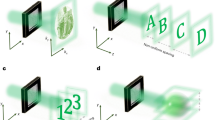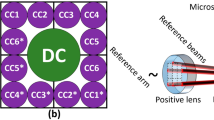Abstract
Holographic three-dimensional (3D) displays1,2 provide realistic images without the need for special eyewear, making them valuable tools for applications that require situational awareness, such as medical, industrial and military imaging. Currently commercially available holographic 3D displays3 use photopolymers that lack image-updating capability, resulting in restricted use and high cost. Photorefractive polymers4,5,6,7,8,9 are dynamic holographic recording materials that allow updating of images and have a wide range of applications, including optical correlation10, imaging through scattering media11 and optical communication12,13. To be suitable for 3D displays, photorefractive polymers need to have nearly 100% diffraction efficiency, fast writing time, hours of image persistence, rapid erasure, and large area—a combination of properties that has not been shown before. Here, we report an updatable holographic 3D display based on photorefractive polymers with such properties, capable of recording and displaying new images every few minutes. This is the largest photorefractive 3D display to date (4 × 4 inches in size); it can be recorded within a few minutes, viewed for several hours without the need for refreshing, and can be completely erased and updated with new images when desired.
This is a preview of subscription content, access via your institution
Access options
Subscribe to this journal
Receive 51 print issues and online access
$199.00 per year
only $3.90 per issue
Buy this article
- Purchase on Springer Link
- Instant access to full article PDF
Prices may be subject to local taxes which are calculated during checkout




Similar content being viewed by others
References
Benton, S. A. Selected Papers on Three-Dimensional Displays (SPIE Optical Engineering Press, Bellingham, Washington, 2001)
Lessard, L. A. & Bjelkhagen, H. I. (eds) Practical Holography XXI: Materials and Applications (Special Issue) Proc. SPIE 6488, (2007)
Zebra Imaging, Inc. 〈http://www.zebraimaging.com〉 (2005)
Ostroverkhova, O. & Moerner, W. E. Organic photorefractives: mechanism, materials and applications. Chem. Rev. 104, 3267–3314 (2004)
Kippelen, B., Meerholz, K. & Peyghambarian, N. in Nonlinear Optics of Organic Molecules and Polymers (eds Nalwa, H. S & Miyata, S.) Ch. 8 507–623 (CRC, Boca Raton, Florida, 1996)
Ducharme, S., Scott, J. C., Twieg, R. J. & Moerner, W. E. Observation of the photorefractive effect in a polymer. Phys. Rev. Lett. 66, 1846–1849 (1991)
Meerholz, K. & Volodin, B. L. Sandalphon, Kippelen, B. & Peyghambarian, N. Photorefractive polymer with high optical gain and diffraction efficiency near 100%. Nature 357, 479–500 (1994)
Marder, S. R., Kippelen, B., Jen, A. K.-Y. & Peyghambarian, N. Design and synthesis of chromophores and polymers for electro-optic and photorefractive applications. Nature 388, 845–851 (1997)
Mecher, E. et al. Near-infrared sensitivity enhancement of photorefractive polymer composites by pre-illumination. Nature 418, 959–964 (2002)
Volodin, B. L., Kippelen, B., Meerholz, K., Peyghambarian, N. & Javidi, B. A Polymeric optical pattern-recognition system for security verification. Nature 383, 58–60 (1996)
Kippelen, B. et al. Near infrared photorefractive polymers and their applications for imaging. Science 279, 54–57 (1998)
Tay, S. et al. Photorefractive polymer composite operating at the optical communication wavelength of 1550nm. Appl. Phys. Lett. 85, 4561–4563 (2004)
Li, G. et al. All-optical dynamic correction of distorted communication signals using a photorefractive polymeric hologram. Appl. Phys. Lett. 86, 161103 (2005)
Chatterjee, M. R. & Chen, S. Digital Holography and Three-Dimensional Display: Principles and Applications (ed. Poon, T.) Ch. 13 379–425 (Springer, New York, 2006)
Pastoor, S. 3D Videocommunication (eds Schreer, O., Kauff. P. & Sikora, T.) Ch. 13 235–251 (John Wiley & Sons, UK, 2005)
Iizuka, K. Welcome to the wonderful world of 3D: introduction, principles and history. Optics Photonics News 17, 42–51 (2006)
Dodgson, N. A. Autostereoscopic 3D displays. Computer 38, 31–36 (2005)
Favalora, G. E. Volumetric 3D displays and application infrastructure. Computer 38, 37–44 (2005)
Downing, E., Hesselink, L., Ralston, J. & Macfarlane, R. A. Three-color, solid-state, three-dimensional display. Science 273, 1185–1189 (1996)
Thayn, J. R., Ghrayeb, J. & Hopper, D. G. 3-D display design concept for cockpit and mission crewstations. Proc. SPIE 3690, 180–186 (1999)
Choi, K., Kim, J., Lim, Y. & Lee, B. Full parallax, viewing-angle enhanced computer-generated holographic 3D display system using integral lens array. Opt. Exp. 13, 10494–10502 (2005)
Miyazaki, D., Shiba, K., Sotsuka, K. & Matsushita, K. Volumetric display system based on three-dimensional scanning of inclined optical image. Opt. Exp. 14, 12760–12769 (2006)
St, Hilaire, P., Lucente, M. & Benton, S. A. Synthetic aperture holography: a novel approach to three dimensional displays. J. Opt. Soc. Am. A 9, 1969–1978 (1992)
Slinger, C. W. et al. Recent developments in computer-generated holography: toward a practical electroholography system for interactive 3D visualization. Proc. SPIE 5290, 27–41 (2004)
Huebschman, M. L., Munjuluri, B. & Garner, H. R. Dynamic holographic 3-D image projection. Opt. Exp. 11, 437–445 (2003)
Hesselink, L., Orlov, S. S. & Bashaw, M. C. Holographic data storage systems. Proc. IEEE 92, 1231–1280 (2004)
Cheng, N., Swedek, B. & Prasad, P. N. Thermal fixing of refractive index gratings in a photorefractive polymer. Appl. Phys. Lett. 71, 1828–1830 (1997)
Halle, M. W. Holographic stereograms as discrete imaging systems. Proc. SPIE 2176, 73–84 (1994)
Benton, S. A. Survey of holographic stereograms. Proc. SPIE 367, 15–19 (1983)
Eralp, M. et al. Submillisecond response of a photorefractive polymer under single nanosecond pulse exposure. Appl. Phys. Lett. 89, 114105 (2006)
Acknowledgements
We acknowledge support by the US Air Force Office of Scientific Research and the Arizona TRIF Photonics programme. We thank A. Schulzgen, M. Eralp and W. J. Plesniak for discussions.
Author information
Authors and Affiliations
Corresponding authors
Supplementary information
Supplementary Video 1
The file contains Supplementary Video 1. This movie shows the operation of the updateable holographic 3D display. It includes 11 minutes of continuous, unaltered video. First, a 3D image is recorded to the 4x4inch PR polymer device and the 3D image is displayed as the video camera moves around the display on a circular track. Then the 3D image is erased using a uniform laser beam at 532nm. Following the erasure, a new 3D image is recorded onto the same area, demonstrating the updating capability of the 3D display. (MOV 76574 kb)
Supplementary Video 2
The file contains Supplementary Video 2. This movie shows several 3D images recorded onto the same PR polymer device. The time lapse covers a period of approximately 1.5 minutes in which the camera moves around the 3D display on a circular track to demonstrate the 3D effect (i.e. occlusion and parallax). (MOV 54280 kb)
Rights and permissions
About this article
Cite this article
Tay, S., Blanche, PA., Voorakaranam, R. et al. An updatable holographic three-dimensional display. Nature 451, 694–698 (2008). https://doi.org/10.1038/nature06596
Received:
Accepted:
Issue Date:
DOI: https://doi.org/10.1038/nature06596
This article is cited by
-
Light sheets for continuous-depth holography and three-dimensional volumetric displays
Nature Photonics (2023)
-
A self-biased non-reciprocal magnetic metasurface for bidirectional phase modulation
Nature Electronics (2023)
-
Tunable liquid crystal grating based holographic 3D display system with wide viewing angle and large size
Light: Science & Applications (2022)
-
Holobricks: modular coarse integral holographic displays
Light: Science & Applications (2022)
-
Highly sensitive updatable green hologram recording polymer with photoisomerizable azobenzene with highly birefringent acetylene as the side chain
Polymer Journal (2021)
Comments
By submitting a comment you agree to abide by our Terms and Community Guidelines. If you find something abusive or that does not comply with our terms or guidelines please flag it as inappropriate.



